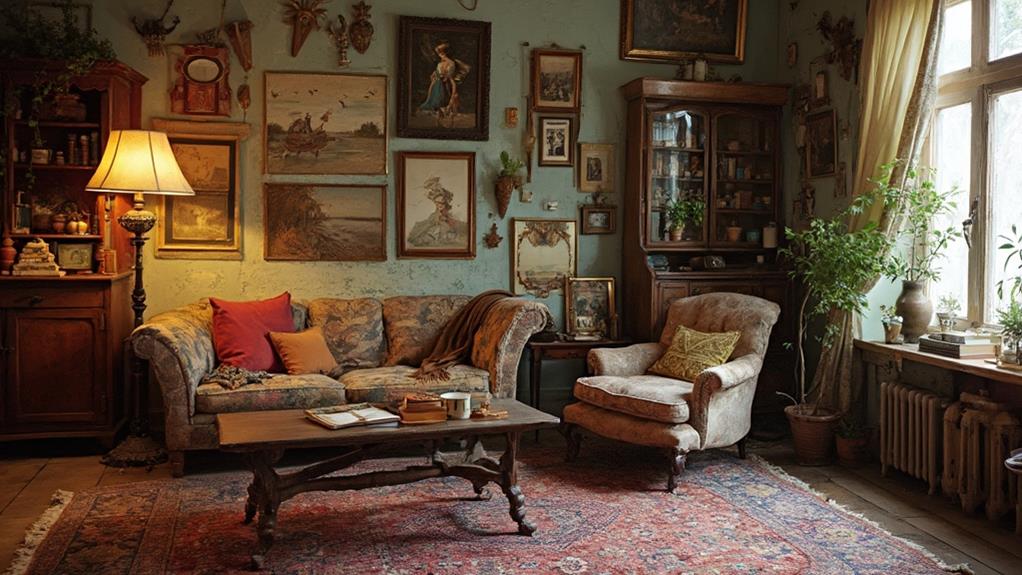Decorating with vintage finds adds unique character and history to your home. Secondhand treasures can be sourced from antique shops, flea markets, estate sales, and online marketplaces. Mixing old and new creates a personalized aesthetic, while upcycling projects breathe new life into worn items. Curate a cohesive look by selecting pieces from complementary eras or styles. Incorporate retro color palettes and vintage accessories to enhance the overall ambiance. This approach not only results in a one-of-a-kind space but also promotes sustainable decorating practices. By exploring the world of vintage decor, you'll uncover endless possibilities for transforming your living space into a stylish, storied haven.
The Appeal of Vintage Decor
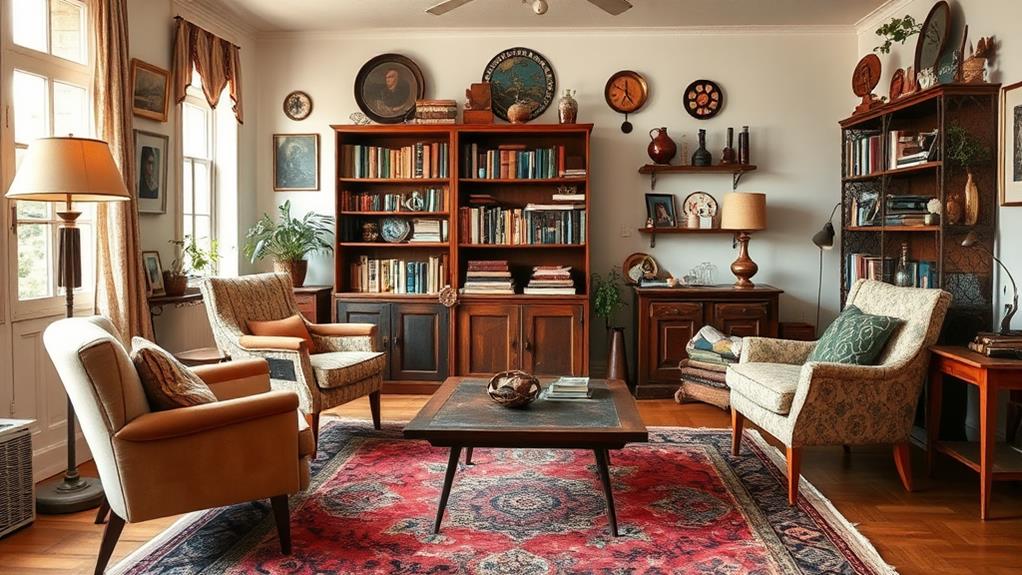
Three key factors contribute to the enduring appeal of vintage decor. First, vintage pieces offer unique character and history that modern mass-produced items often lack. Each antique or retro item tells a story, adding depth and personality to your living space.
Second, incorporating vintage elements into your home decor creates a sense of nostalgia and warmth, evoking memories of bygone eras and connecting us to the past.
Lastly, vintage decor is an environmentally conscious choice. By repurposing and reusing older items, you reduce waste and minimize your carbon footprint. This sustainable approach to decorating aligns with the growing trend of eco-friendly living.
Vintage decor also allows for creative expression and personalization. Mixing and matching pieces from different periods and styles creates a curated, one-of-a-kind look that reflects your individual taste. Additionally, vintage items often boast superior craftsmanship and materials compared to their modern counterparts, ensuring longevity and value. Whether you're drawn to mid-century modern furniture, Art Deco accessories, or Victorian-era textiles, incorporating vintage finds into your home decor adds character, sustainability, and timeless elegance to your living space.
Where to Find Secondhand Treasures
Numerous sources exist for discovering vintage and secondhand treasures to enhance your home decor. Antique shops and flea markets are traditional haunts for vintage enthusiasts, offering a wide array of unique items from different eras. Estate sales provide an opportunity to find high-quality pieces at reasonable prices, often from complete collections or curated homes.
Thrift stores and charity shops are excellent for budget-friendly finds, though they may require more frequent visits to uncover hidden gems. Online marketplaces like eBay, Etsy, and Facebook Marketplace have expanded the reach of vintage shopping, allowing access to items from around the world. Specialty vintage stores focus on specific eras or styles, making them ideal for collectors or those with a particular aesthetic in mind.
Auction houses offer higher-end vintage and antique pieces, often with provenance and expert appraisals. For those willing to put in more effort, garage sales and yard sales can yield surprising finds at bargain prices. Lastly, salvage yards and architectural salvage shops are perfect for sourcing unique structural elements, hardware, and larger statement pieces that can add character to any space.
Mixing Old and New
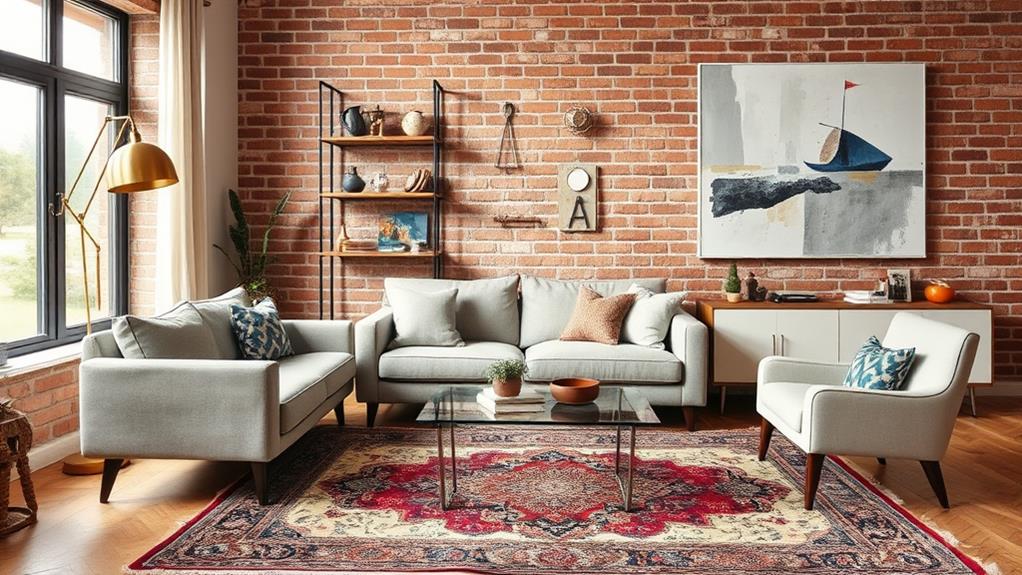
Blending vintage finds with modern elements is a key aspect of creating a dynamic and personalized home decor. This approach allows you to showcase your unique style while maintaining a fresh and contemporary feel. To successfully mix old and new, consider the following strategies:
First, establish a cohesive color palette that ties together both vintage and modern pieces. This creates visual harmony and prevents the space from feeling disjointed.
Next, use contrast to your advantage by pairing sleek, minimalist furniture with ornate vintage accessories or vice versa. Balance is crucial; aim for a 70/30 or 60/40 ratio of new to old items to avoid overwhelming the space.
Incorporate vintage textiles, such as throw pillows or area rugs, to add warmth and texture to modern furnishings. Repurpose antique items for unexpected uses, like turning an old ladder into a bookshelf or using vintage suitcases as side tables.
Upcycling and DIY Projects
Upcycling and DIY projects offer creative ways to incorporate vintage finds into your home decor while adding a personal touch. These techniques allow you to transform outdated or worn items into unique, functional pieces that reflect your style and creativity.
One popular upcycling approach is repurposing vintage furniture. For example, an old dresser can be transformed into a bathroom vanity or a kitchen island with some sanding, painting, and new hardware. Similarly, wooden ladders can become stylish bookshelves, and antique suitcases can be stacked to create a quirky side table.
DIY projects using vintage materials can also yield stunning results. Create custom wall art by framing vintage maps, postcards, or fabric swatches. Craft unique lighting fixtures using old mason jars, colanders, or even vintage birdcages. For a rustic touch, repurpose barn wood or salvaged doors into headboards or dining tables.
When undertaking upcycling and DIY projects, consider the item's original charm and how to enhance it. Sometimes, a simple cleaning and minor repairs are all that's needed to breathe new life into a vintage piece. Remember to use appropriate tools and materials to ensure your creations are safe and durable.
Curating a Cohesive Vintage Look
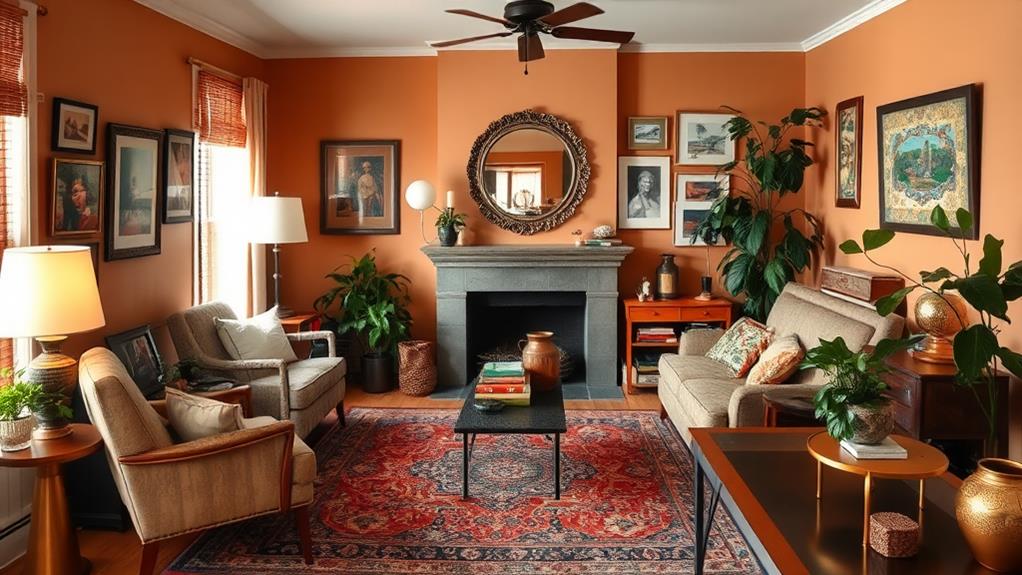
Harmony is key when curating a cohesive vintage look for your home. To achieve this, focus on selecting pieces from complementary eras or styles that share common design elements. Consider color palettes, materials, and shapes that work well together, creating a unified aesthetic throughout your space.
When mixing different vintage periods, establish a dominant style and use accents from other eras to add depth and interest. For example, a mid-century modern foundation can be enhanced with Art Deco accessories or Victorian-era textiles. Pay attention to scale and proportion, ensuring larger furniture pieces don't overwhelm smaller vintage finds.
Create visual continuity by repeating design elements, such as specific colors, patterns, or materials, across different rooms. This approach helps tie the overall look together while allowing each space to maintain its unique character. Incorporate vintage lighting fixtures, artwork, and textiles to reinforce the cohesive aesthetic.
Remember that curating a cohesive vintage look is an ongoing process. Take time to refine your collection, swapping out pieces that don't quite fit and introducing new finds that enhance the overall harmony of your home's decor.
Vintage Furniture Restoration Tips
While curating a cohesive vintage look sets the stage for your home's aesthetic, restoring vintage furniture pieces can elevate your decor to new heights. Begin by thoroughly cleaning the item using appropriate methods for its material. For wood, a mild soap and water solution often suffices, while metal may require specialized cleaners to remove rust and tarnish.
Assess the piece for structural integrity, repairing loose joints or damaged areas before refinishing. When stripping old paint or varnish, use chemical strippers or heat guns cautiously to avoid damaging the underlying material. Sand surfaces smooth, progressing from coarse to fine-grit sandpaper.
Choose a finish that complements your decor while protecting the piece. Options include paint, stain, varnish, or wax. Apply thin, even coats, allowing proper drying time between applications. For upholstered items, consider reupholstering with period-appropriate fabrics to maintain authenticity.
Pay attention to hardware, cleaning or replacing knobs, pulls, and hinges as needed. Antique brass can be polished with a mixture of lemon juice and baking soda. Finally, protect your restored piece with regular maintenance, including dusting, polishing, and addressing any new damage promptly to preserve its beauty.
Incorporating Retro Color Palettes
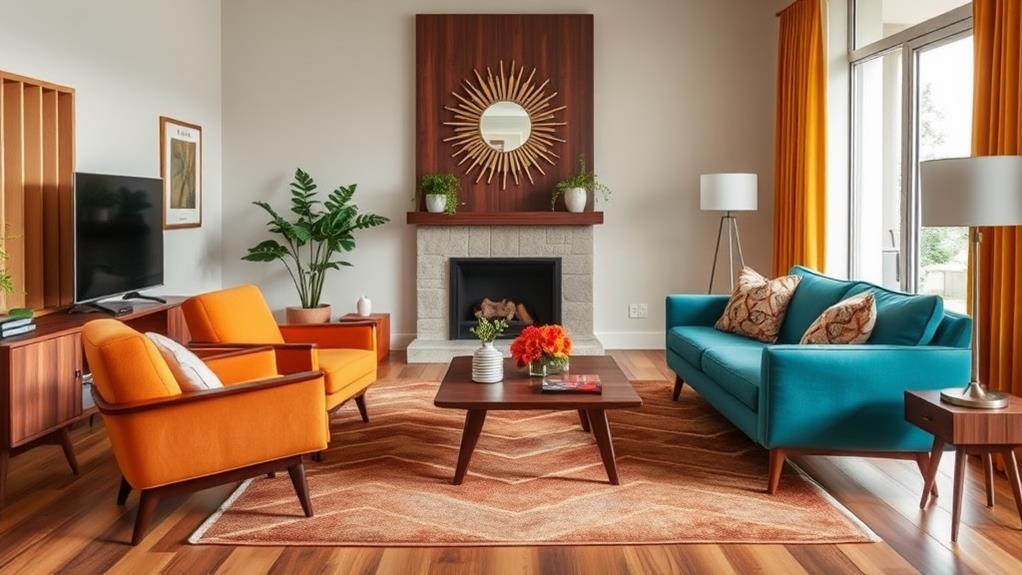
Retro color palettes can breathe new life into your vintage-inspired home decor. These vibrant and nostalgic hues evoke specific eras and add character to your space. To successfully incorporate retro colors, focus on specific decades for inspiration.
The 1950s favored pastels like mint green, baby blue, and pale pink, often paired with bold black accents. The 1960s embraced psychedelic combinations, featuring saturated oranges, yellows, and purples.
For a 1970s vibe, consider earthy tones like avocado green, harvest gold, and burnt orange. The 1980s brought neon brights and Miami Vice-inspired pastels. When applying these palettes, use the 60-30-10 rule: 60% dominant color, 30% secondary color, and 10% accent color. This creates visual balance and prevents overwhelming the space.
Integrate retro colors through painted accent walls, vintage fabrics, or colorful accessories. Combine them with neutral tones to create a modern twist on classic looks. Remember that retro colors can be bold, so use them judiciously to avoid a kitschy or dated appearance. By carefully selecting and applying retro color palettes, you can create a unique and stylish vintage-inspired home.
Styling With Vintage Accessories
Styling with vintage accessories can transform a space, infusing it with character and nostalgia. These unique pieces provide a connection to the past and add depth to modern interiors. When incorporating vintage accessories, focus on creating deliberate arrangements that highlight their distinctive features.
Mix different eras and styles to create an eclectic, curated look. Combine Art Deco mirrors with mid-century modern vases, or pair Victorian picture frames with retro clocks. Group similar items together for impact, such as a collection of vintage cameras or antique books. Use vintage trays, boxes, or suitcases as decorative storage solutions that double as eye-catching displays.
Consider functionality when selecting vintage accessories. Repurpose old ladders as towel racks or use antique mason jars as unique vases. Vintage lamps, doorknobs, and hardware can add character to everyday items. Don't overlook textiles; vintage quilts, tapestries, or embroidered pieces can serve as wall art or throw blankets. Remember to balance vintage elements with contemporary pieces to prevent the space from feeling dated or cluttered. By thoughtfully integrating vintage accessories, you can create a personalized, timeless interior that tells a story.
Telling Stories Through Decor
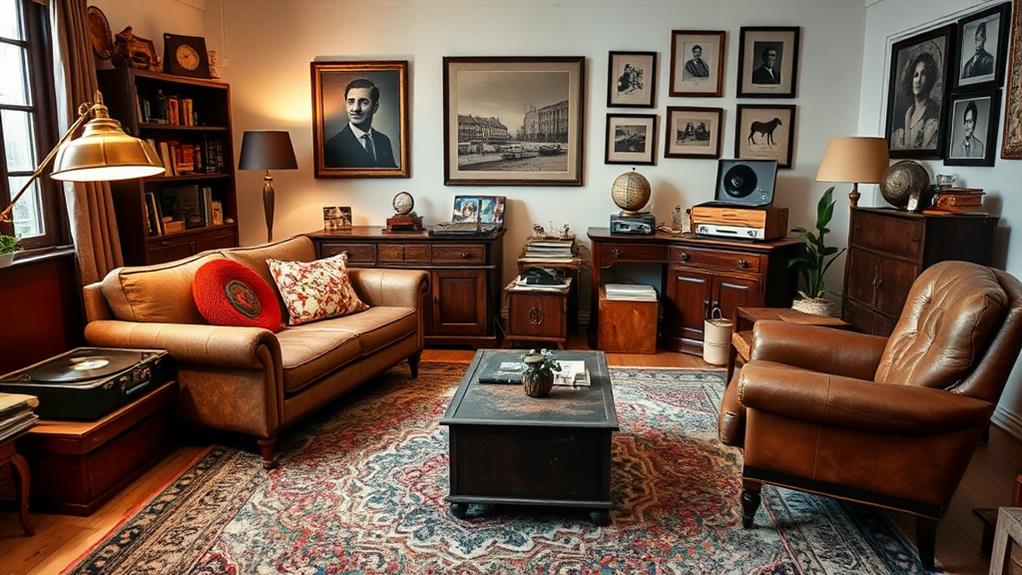
Nostalgia and personal history intertwine when telling stories through decor. Vintage finds offer a unique opportunity to create narratives within your living spaces, transforming your home into a curated collection of memories and experiences. Each piece becomes a conversation starter, inviting guests to explore the stories behind your decor choices.
Incorporate family heirlooms, travel souvenirs, and flea market treasures to weave a rich tapestry of personal history throughout your home. Display old photographs in antique frames, or repurpose vintage suitcases as side tables to evoke a sense of wanderlust. Arrange collections of vintage books or vinyl records to showcase your interests and passions.
Consider grouping items that share a common theme or era to create cohesive vignettes. For example, a mid-century modern sideboard paired with retro glassware and a vintage radio can transport visitors to a bygone era. Layer textures and materials to add depth and intrigue to your storytelling displays. By thoughtfully curating your vintage finds, you can create a home that not only reflects your personal style but also tells the unique story of your life and experiences.
Sustainable Decorating With Secondhand Items
Beyond storytelling, decorating with vintage finds offers a sustainable approach to home design. By choosing secondhand items, you reduce the demand for new production, conserving resources and energy. Vintage pieces often boast superior craftsmanship and durability, ensuring longevity in your home and minimizing waste.
Incorporating pre-loved items into your decor helps divert objects from landfills, giving them new life and purpose. This practice aligns with circular economy principles, promoting reuse and reducing environmental impact. Secondhand shopping also typically involves local thrift stores, antique shops, or online marketplaces, supporting community businesses and reducing transportation emissions associated with new goods.
Vintage decorating encourages creativity and uniqueness. Mix-and-match styles create eclectic, personalized spaces that reflect your taste and values. Repurposing items for alternative uses, such as turning an old ladder into a bookshelf, further enhances sustainability.
When selecting vintage pieces, consider their condition and potential for restoration. Refinishing or reupholstering can breathe new life into worn items while maintaining their character. By embracing sustainable decorating with secondhand items, you create a home that's not only stylish but also environmentally responsible.
Frequently Asked Questions
How Do I Authenticate Vintage Pieces to Ensure They're Not Reproductions?
To authenticate vintage pieces, research the item's history, examine materials and craftsmanship, look for maker's marks, and consult experts. Utilize online resources, reference books, and reputable antique dealers for verification. Consider professional appraisals for valuable or rare items.
What Are the Best Cleaning Methods for Delicate Vintage Textiles?
Holy smokes! Cleaning delicate vintage textiles requires gentle care. Use a soft brush to remove dust, then spot-clean with mild soap and cold water. For stubborn stains, consult a professional conservator. Always test cleaning methods on an inconspicuous area first.
How Can I Determine the Fair Market Value of Vintage Decor Items?
To determine fair market value for vintage decor items, research comparable sales on platforms like eBay and Etsy, consult price guides, seek expert appraisals, and consider factors such as condition, rarity, and provenance. Auction results can also provide valuable insights.
Are There Health Concerns Associated With Using Vintage Furniture or Decor?
Like Pandora's box, vintage items may harbor hidden concerns. Health risks can include lead paint, asbestos, mold, and pests. However, proper cleaning, restoration, and inspection can mitigate these issues, allowing safe enjoyment of vintage furniture and decor.
What Insurance Considerations Should I Keep in Mind for Valuable Vintage Pieces?
For valuable vintage pieces, consider specialized insurance coverage beyond standard homeowners policies. Obtain professional appraisals, document items thoroughly, and review coverage limits. Some insurers offer specific antique or collectibles policies for comprehensive protection of high-value vintage items.
Conclusion
Vintage decor transcends mere aesthetics, becoming a monumental force in sustainable design. The unparalleled allure of secondhand treasures transforms homes into veritable museums, each item whispering centuries of history. Mixing old and new creates a symphony of styles, while upcycling breathes new life into forgotten relics. The art of curating vintage pieces elevates spaces to extraordinary heights, weaving intricate narratives through carefully selected artifacts. This approach to decorating not only revolutionizes interiors but also propels society towards an unparalleled era of conscious consumption and environmental stewardship.
